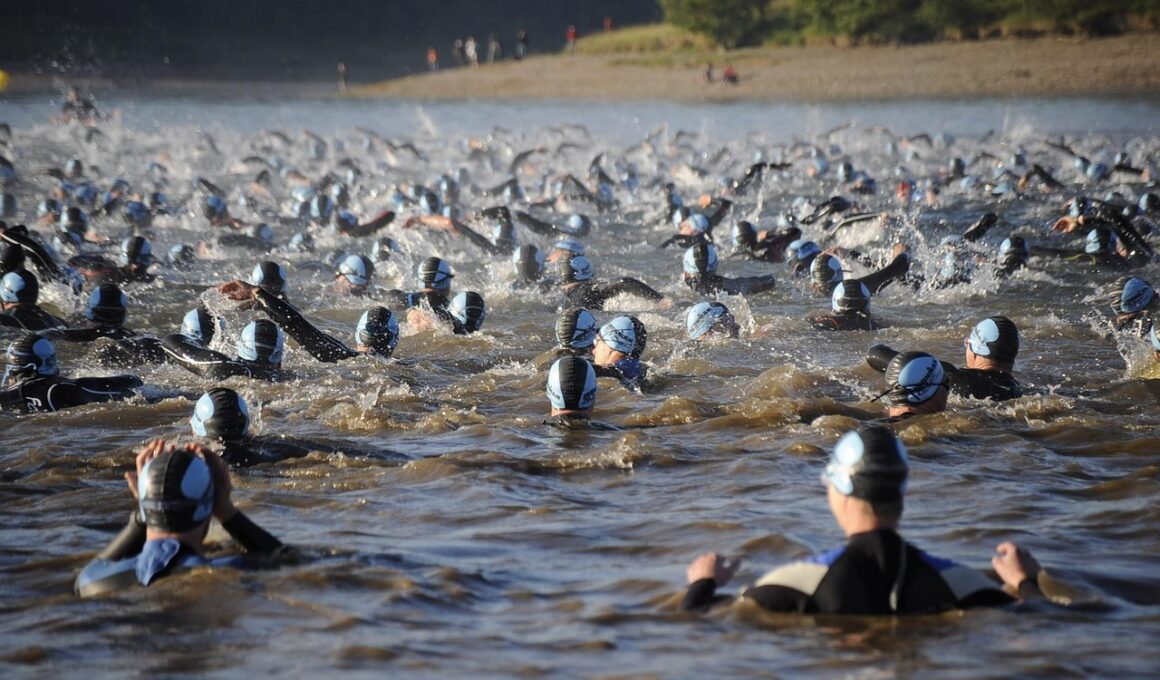Effective Warm-Up and Cool-Down for Open Water Swimming
Swimming in open water is different from practicing in a pool, necessitating a tailored warm-up routine. Start your warm-up with dynamic stretches, focusing primarily on the arms, shoulders, and legs. This helps enhance flexibility and prepares your body for the demands of swimming. Include movements such as arm circles, trunk twists, and leg swings. After stretching, you can transition to light swimming in shallow water. Gradually increase your intensity by incorporating swim drill patterns; this will acclimate your body to the cooler temperature of open water. Always remember to engage in breath control exercises, as managing your breathing effectively is crucial. Once you’ve completed your warm-up, assess how your body feels and ensure you are adequately prepared mentally and physically for your main swim. Open water swimming often exposes you to currents and waves, so it’s vital to feel agile before diving in. Totally commit to your warm-up routine as it sets the tone for your endurance and efficiency during longer swim sessions.
Your cool-down routine after an open water swim is just as vital as your warm-up. The goal is to gradually lower your heart rate and help your muscles recover. Start by swimming at a slow pace for about 5-10 minutes, allowing your body to transition back from high exertion. Following your swim, devote some time to static stretching to improve flexibility and soothe tired muscles. Focus on the key muscle groups used during your workout: arms, shoulders, and core. Each stretch should be held for about 15-30 seconds. Incorporate a mix of arm stretches, side bends, and hip openers to maximize recovery efficiency. Hydration is also paramount during the cool-down phase; ensure you drink water or an electrolyte-rich beverage to replenish lost fluids. Always listen to your body—if you experience any stiffness or soreness, consider longer stretches or foam rolling to boost recovery. Maintaining a structured cool-down not only aids physical recovery but also helps in preventing injuries, making it an essential part of every open water swimming session.
Strategies for Effective Warm-Up
Integrating varied strategies into your warm-up can yield remarkable performance benefits. Begin by incorporating practice drills that mimic the type of swimming you will be doing during your main workout. For example, if you plan to swim longer distances, include drills that involve longer, sustained strokes. It’s also helpful to simulate actual swim conditions by practicing in waves or currents if possible. If you swim in a group, organize specific warm-up protocols that everyone can follow for consistency. Incorporating mental visualization techniques during warm-up can be beneficial. Picture yourself swimming with perfect form and breathing technique. This visualization can invigorate confidence and focus, essential attributes for any open water swimmer’s success. Always remember to stay aware of the weather and water conditions; prepare your warm-up accordingly. If it’s particularly cold, you may want to increase your pre-swim activities to ensure your muscles are adequately warmed without risking injury. A focused warm-up not only enhances performance but also brings a sense of serenity before entering open water.
A proper cool-down strategy following your swim allows you to reflect on the session and set goals for improvement. Not only does it facilitate physical recovery, but it also encourages mental clarity. Close your swim session by doing a few slow laps; this transitional approach helps in regulating your heart rate. During the cool-down, think about your performance: What went well? What can be adjusted next time? This reflective practice reinforces your swimming techniques and strategy reinforcement. Post-cool-down stretches are optimal for enhancing flexibility; focus on areas that may feel tight or sore after your swim. Engaging with other swimmers or discussing your session can further enhance the learning experience. Consider writing down your reflections in a training journal; this aids in tracking progress over time. If you are preparing for an upcoming event, incorporate additional stretches targeting specific swim muscles into your cool-down routine. Having a clear recovery plan can differentiate between fatigue and fitness gains, allowing you to swim better in future sessions.
Importance of Hydration
Maintaining proper hydration before, during, and after your swim is crucial to achieving optimal performance. Dehydration can seriously hamper not only your swim times but can lead to cramps and fatigue. Begin by hydrating the night before your swim, and consume fluids throughout the day. During your warm-up, don’t forget to sip on water or a sports drink to maintain electrolyte balance as well. If swimming in cooler waters, dehydration symptoms can sometimes go unnoticed; therefore, it’s vital to have a consistent hydration plan in place. After your swim, make sure to replenish any lost fluids, focusing both on water and electrolyte recovery drinks. A good rule of thumb is to drink about 500ml for every hour of swimming. Adding salt tablets can also help replace lost sodium, especially during longer swims. Keeping your hydration routine consistent not only fosters better performance but also aids in recovery, making your swim training more effective. When it comes to open water swimming, consider hydration an integral part of improving your overall swimming experience.
Besides your physical preparation, mental readiness is essential for successful open water swimming. Address any anxieties you experience regarding open water by incorporating breathing techniques and visualizations into your warm-up effective strategies. Visualization should involve imagining the feel of the water and the movements of your swimming strokes. This can calm nerves and enhance confidence when you enter the water. As with any sport, setting clear and achievable goals are also beneficial. Create short-term and long-term objectives for your swim training; it helps maintain focus and motivation. Each swim should feel purposeful, leading toward these objectives. Document your progress and celebrate accomplishments, no matter how small. This practice can build psychological resilience, preparing you for challenges. A supportive environment affects emotional readiness as well; swim with friends or join groups to cultivate camaraderie while preparing for open water sessions. Learning to embrace challenges and focusing on enjoying every moment spent in the water can lead to a far richer experience overall. In open water swimming, readiness both on physical and mental levels sets the stage for success.
Addition of Safety Measures
Integrating safety measures into your open water swimming routine is paramount. Always swim in areas designated for swimmers and make sure someone knows your plans before entering the water. Consider using swimming buoy markers, as they can enhance visibility and provide you with a point of rest if needed. When preparing for your swim, check the weather conditions and currents to ensure safety. If conditions seem too rough, do not hesitate to postpone your swim. Joining open water swim groups can also enhance safety, allowing you to swim alongside others rather than alone. Additionally, consider wearing a wetsuit if water temperatures are low; it not only keeps you warm but makes you more buoyant. Always carry a quick-access flotation device if swimming longer distances. Establish a communication plan with any companions to stay in touch while swimming. Staying aware of your surroundings is crucial; ensure you’re prepared to react if wildlife is present. By taking these safety measures seriously, you protect not just yourself, but create a positive atmosphere for fellow swimmers as well.
Ultimately, incorporating effective warm-up and cool-down routines in open water swimming is vital for enhancing overall performance. A systematic approach prepares your body by loosening tight muscles and readying your mind, helping you embrace the challenges ahead. Visualize yourself in the water, racing with finesse, as you engage in warm-up drills. Focus on hydration before, during, and after training sessions as crucial to your success. Reflect on your swims post-training for improved performance in upcoming sessions. Remember that swimming is a long-term journey; don’t rush the process. Promote connection with fellow swimmers to build a supportive community that can enhance your experience. Training for open water swimming involves understanding its unique aspects and skills. So be consistent with your routines, and keep refining your techniques. By enhancing both your physical and mental fitness, you can enjoy open water swimming while performing at your best. The journey of open water swimming is fulfilling; the more dedicated you are to your warm-up and cool-down practices, the better your experience and results will be. Embrace the joy of swimming while ensuring you’re prepared to face each wave.


